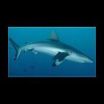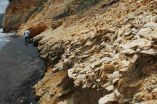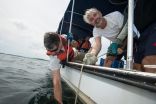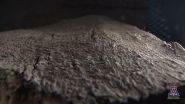Fossils inform marine conservation
2015-04-30
(Press-News.org) The fossil record helps to predict which kinds of animals are more likely to go extinct. When combined with information about hotspots of human impacts and climate-change predictions, Smithsonian scientists and colleagues pinpoint animal groups and geographic areas of highest concern for marine conservation in the May 1 issue of Science magazine.
"Just as some groups of people are more prone to health problems like diabetes or heart disease, we can tell from the fossil record which groups of animals are naturally more likely to go extinct," said Aaron O'Dea, paleontologist at the Smithsonian Tropical Research Institute.
"Our calculations suggest that the animal's geographic range and the group they belong to are the best predictors of extinction risk," said Carl Simpson, coauthor and post-doctoral researcher at the Smithsonian's National Museum of Natural History. The study reveals that marine mammals, sharks and corals are animals that have naturally high risks of extinction.
Plotting this data globally, the study suggests that the Tropical West Atlantic and Tropical West Pacific are at potentially greatest risk to naturally high levels of extinction. Unfortunately these areas are also predicted to experience the fastest rates of climate change and greatest future human impact, such as habitat destruction, overfishing and pollution.
"There is a lot to be refined, but life in tropical seas appears to be naturally prone to extinction and is under increasing stress from human activities," O'Dea said. "It's a daunting combination that suggests the great diversity of tropical seas might need much greater protection than it has previously received."
INFORMATION:
The Smithsonian Tropical Research Institute, headquartered in Panama City, Panama, is a part of the Smithsonian Institution. The institute furthers the understanding of tropical nature and its importance to human welfare, trains students to conduct research in the tropics and promotes conservation by increasing public awareness of the beauty and importance of tropical ecosystems. Website: http://www.stri.si.edu
Finnegan, S., Anderson, S.C., Harnik, P.G., Simpson, C., Tittensor, D.P., Byrnes, J.E., Finkel, Z.V., Lindberg, D.R., Liow, L.H., Lockwood, R., Lotze, H.K., McClain, C.M., McGuire, J.L., O'Dea, A. and Pandolfi, J.M., 2015. Paleontological baselines for evaluating extinction risk in the modern oceans. Science
ELSE PRESS RELEASES FROM THIS DATE:
2015-04-30
If you thought that a beetle with a machine gun built into its rear end was something that only exists in sci-fi movies, you should talk to Wendy Moore at the University of Arizona.
Many beetles secrete foul-smelling or bad-tasting chemicals from their abdomens to ward off predators, but bombardier beetles take it a step further. When threatened, they combine chemicals in an explosive chemical reaction chamber in their abdomen to simultaneously synthesize, heat and propel their defensive load as a boiling hot spray, complete with "gun smoke." They can even precisely ...
2015-04-30
SEATTLE, Wash. -- More than 1000 dams have been removed across the United States because of safety concerns, sediment buildup, inefficiency or having otherwise outlived usefulness. A paper published today in Science finds that rivers are resilient and respond relatively quickly after a dam is removed.
"The apparent success of dam removal as a means of river restoration is reflected in the increasing number of dams coming down, more than 1,000 in the last 40 years," said lead author of the study Jim O'Connor, geologist with the U.S. Geological Survey. "Rivers quickly erode ...
2015-04-30
CAMBRIDGE, Mass--Bombardier beetles, which exist on every continent except Antarctica, have a pretty easy life. Virtually no other animals prey on them, because of one particularly effective defense mechanism: When disturbed or attacked, the beetles produce an internal chemical explosion in their abdomen and then expel a jet of boiling, irritating liquid toward their attackers.
Researchers had been baffled by the half-inch beetles' ability to produce this noxious spray while avoiding any physical damage. But now that conundrum has been solved, thanks to research by a ...
2015-04-30
The vivid pigmentation of zebras, the massive jaws of sharks, the fight or flight instinct and the diverse beaks of Darwin's finches. These and other remarkable features of the world's vertebrates stem from a small group of powerful cells, called neural crest cells, but little is known about their origin.
Now Northwestern University scientists propose a new model for how neural crest cells, and thus vertebrates, arose more than 500 million years ago.
The researchers report that, unlike other early embryonic cells that have their potential progressively restricted as ...
2015-04-30
ORANGE, Calif. - Researchers in Chapman University's Argyros School of Business and Economics and their collaborators have just published a study on the evolution of yoga in the marketplace. Assistant Professor Gokcen Coskuner-Balli, Ph.D., co-authored the study, which examined how the meaning of yoga transformed in the past three decades. The results show that yoga became decreasingly associated with spirituality and increasingly associated with medicine and fitness. The study argues that the shift in the meanings are due to the changes in how yoga gurus are trained, market ...
2015-04-30
Flowering plants, also known as angiosperms, add an allure to the world that is unlike anything else in nature, but more importantly, they sustain us. Most of the fruits, vegetables, grains, beans, nuts, and even herbs and spices that we consume are produced by flowering plants. They all belong to the green plant branch of the tree of life, and a novel DNA analysis software program named MarkerMiner facilitates identification of genes that can be used to elucidate the evolutionary relationships between them.
University of Florida (UF) biologist Srikar Chamala, working ...
2015-04-30
Over the past 35 years, California's high-wage workers have seen steady increases in their paychecks. But low-wage workers, 4.8 million strong and about one-third of the state's workforce, earned less in inflation-adjusted dollars in 2014 than they did in 1979, according to an analysis from the University of California, Berkeley.
UC Berkeley researchers analyzing U.S. Census Bureau data at the campus's Center for Labor Research and Education found that low-wage workers, defined as those earning hourly wages of $13.63 or less, have seen steady declines in their inflation-adjusted ...
2015-04-30
As the number of bills passed by Congress declines, fewer and fewer Congressional representatives are voting across party lines, leaving only a few key representatives as collaborative voters, according to researchers.
"We can't say for sure that the decline in cooperation is the sole reason that there are fewer bills being introduced or passed by Congress, but we do know the two are statistically correlated, and both have been dropping steadily over the past 60 years," said Clio Andris, lead author and assistant professor of geography at Penn State.
The researchers ...
2015-04-30
China's government and other sources say that the country's carbon-dioxide emissions flattened out between 2013 and 2014. The leveling-off was a remarkable feat that could set the country on a course to beating its own goals for lowering emissions. But this optimistic outcome hinges on China overcoming some serious energy challenges, according to an article in Chemical & Engineering News (C&EN), the weekly newsmagazine of the American Chemical Society.
Steven Gibb, a senior editor at C&EN, reports that a number of factors could help explain the emissions plateau. China ...
2015-04-30
How and when does mom feed her embryo? We humans, like most mammals, experience pregnancy where a mother supplies nutrition directly to the embryo as it develops. But we're in the minority.
Most members of the animal kingdom supply eggs with nutritious yolk before they are fertilized. With this yolk supply, fertilized eggs develop as embryos in the environment outside the mother's body. For over a century, the scientific understanding of matrotrophy ("mother-feeding") of an embryo developing inside a mom's body has come from vertebrate animals, especially mammals like ...
LAST 30 PRESS RELEASES:
[Press-News.org] Fossils inform marine conservation



